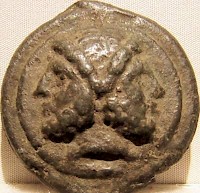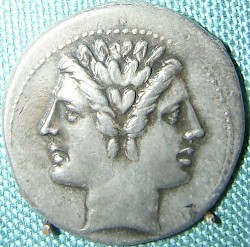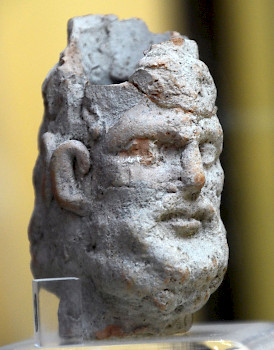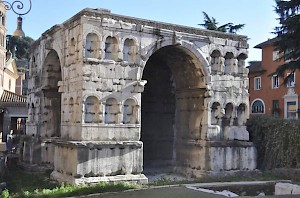Janus
Janus: two-headed Roman god of doors and beginnings.

The temple of Janus in Rome was situated in a street named Argiletum, an important road that connected the Roman Forum and the residential areas in the northeast. It was a small, wooden temple, and the building material suggests that the cult of Janus was of a venerable old age. This is confirmed by several facts. The oldest lists of gods usually began with his name; he was surnamed divom deus, a very ancient form of Latin meaning "the god's god"; and his portrait can be found on the oldest Roman coins. Janus was, therefore, a very old and important Roman god. Before every sacrifice, he was invoked and received a libation.
But this does not mean that modern scholars really understand the cult of the god of doors (ianuae) and beginnings. Neither did the Romans themselves. During the reign of the emperor Augustus (27 BCE - 14 CE), they started to connect things with the cult of Janus that originally had nothing to do with it. Unfortunately, we have hardly any texts that antedate this period, which makes it impossible to reconstruct the original cult. The only thing we know about it, is that the god was also venerated in several other towns in the Tiber valley.

The temple in the Argiletum consisted of two gates; the cult statue was between them. It was a very ancient statue; the author Pliny the Elder mentions it as proof that the sculptor's art existed in Italy in the earliest times.note The god was portrayed with two bearded heads. The fingers of his hands were placed in strange positions, which Pliny interpreted as an indication of the number 355, which he thought was a reference to the number of days of the oldest Roman calendar. This may be true, but it is, of course, pure speculation.
Other speculations are mentioned by Plutarch of Chaeronea, a Greek author living in the early second century, but using a source that can be dated between 29 and 25 BCE:
Janus also has a temple at Rome with double doors, which they call the gates of war; for the temple always stands open in time of war, but is closed when peace has come. The latter was a difficult matter, and it rarely happened, since the realm was always engaged in some war, as its increasing size brought it into collision with the barbarous nations which encompassed it round about. But in the time of Augustus it was closed, after he had overthrown Mark Antony; and before that, when Marcus Atilius and Titus Manlius were consuls, it was closed a short time; then war broke out again at once, and it was opened.note
Plutarch goes on to say that during the reign of the legendary king Numa, the gates were always closed, and that Numa had invented the rule that they were to remain open in wartime. But this cannot be true. In the fifth and fourth centuries, there were several warless years, but the gates were not closed; and we simply do not know why Manlius closed the gate in 235 BCE. The legend about Numa is not found in our sources until a century later.note
The emperor Augustus wrested the legend from oblivion. In his autobiography, he tells:
It was the will of our ancestors that the gateway of Janus Quirinus should be shut when victories had secured peace by land and sea throughout the whole empire of the Roman people; from the foundation of the city to my birth, tradition records that it was shut only twice [by Numa and Manlius], but while I was the leading citizen the Senate resolved that it should be shut on three occasions.note
The gate was locked for the first time in January 29, after Augustus had defeated Mark Antony and Cleopatra, and again in the autumn of 25, when the Spanish Cantabrians were subdued. The Christian author Orosius states that the gates of Janus were closed for the third time in 1 BCE, and remained closed for no less than twelve years.note This tells more about Orosius' theological than historical interests: during the twelve years of Christ's childhood, the Romans were involved in several wars (e.g., in Germania, where they suffered a famous defeat in the Teutoburg Forest). The truth is that we do not known when the gates were closed for the third time.

The poet Virgil helped the emperor invent the tradition. In the Aeneid, the national epic of the Romans, the simple fact that every consul left the Roman Forum through the Argiletum (Rome's most important road) is blown up to an ancient ritual:
There was a sacred custom in Latium, Land of the West, which the Alban Cities continuously observed, and Rome, supreme in all the world, observes today when Romans first stir Mars to engage battle, alike if they prepare to launch war's miseries with might and main on Getae, Hyrcanians, or Arabs, or to journey to India, in the track of dawn, and to bid the Parthians hand our standards back. There are twin Gates of War, for by that name men call them; and they are hallowed by men's awe and the dread presence of heartless Mars. A hundred bars of bronze, and iron's tough, everlasting strength, close them, and Janus, never moving from that threshold, is their guard. When the senators have irrevocably decided for battle, the consul himself, a figure conspicuous in Quirine toga of State and Gabine cincture, unbolts these gates, and their hinge-posts groan; it is he who calls the fighting forth, then the rest of their manhood follows, and the bronze horns, in hoarse assent, add their breath.note
In another passage, Virgil explains the meaning of the ritual closing of the gates:
The terrible iron-constricted Gates of War shall shut; and safe within them shall stay the godless and ghastly Lust of Blood, propped on his pitiless piled armory, and still roaring from gory mouth, but held fast by a hundred chains of bronze knotted behind his back.note
In other words: the gates were closed to keep War in. However, Virgil's contemporaries an colleagues Ovid and Horace state exactly the opposite: it is Peace that is kept inside the temple of Janus.note To make things more complex, Augustus also built an Altar of Peace.

In spite - or rather: because - of this ambiguity, the closing of the Gates of War was a powerful symbol. Later emperors used it as well. After Nero's general Corbulo had defeated the Parthians, the ruler shut the doors in 66. Coins with the legend PACE Popvlis Romanis VBIQve PARTA IANVM CLVSIT ("He closed the gate of Janus when the Roman people everywhere enjoyed peace") were struck to commemorate this occasion. In 75, it was Vespasian's turn.
The historian Eutropius informs us that Gordian III opened the doors in 241.note We are forced to accept that the gates had been closed for almost 170 years. If the doors had been open all the time and a second-century emperor had closed them, he would have minted coins, and archaeologists would have found these. But they have not been discovered, and this forces us to accept that the gates were closed, even though emperors like Trajan, Marcus Aurelius and Septimius Severus were well-known warriors.
In the meantime, the cult had changed. The emperor Domitian had changed the old cult statue and replaced it with a bust with four heads, which oversaw four forums: the Forum of Peace, the Forum Transitorium, the Forum of Julius Caesar, and the Roman Forum. This is told by the poet Martial,note and his words enable us to establish the place of the temple in the immediate neighborhood of the Senate building (Curia Julia). Excavations in 1997-2000 did not result in a more precise identification of the foundation of the wooden shrine (instead, a monumental farm from the age of Charlemagne was discovered).

The temple of the Argiletum with the Gates of War was not the only place where the Romans worshipped Janus. On the other side of the Tiber, an altar was dedicated to this god on the 'hill of Janus' (Ianiculum). A second altar was erected on the hill Oppius, which played a role in the ceremonies when a boy became a man. Consul Marcus Duillius built a temple on the Vegetable's Market (Forum Holitorium), after his naval victory off Mylae (260 BCE). It was rebuilt by the emperor Tiberius. In this temple, twelve altars were erected, dedicated to the twelve months (one of them, January, was perhaps called after the god). Finally, there was the Arch of the four-faced Janus, Janus Quadrifrons, at the Velabrum.